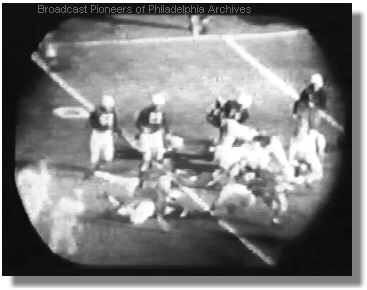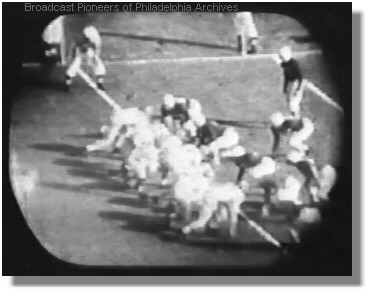


Actual night broadcast taken from a TV monitor
Temple University Football
W3XE, Channel 3
Saturday, November 11, 1939
![]()
On Saturday, November 11, 1939, W3XE broadcast a nighttime football game. Originally, it was believed to have been Temple vs. Kansas. Unfortunately, during the entire 1939 season, these two teams didn't play each other and we know it was 1939. Looking at the college schedule for that year, there was only one day where both teams were playing and that was Saturday, November 11, 1939.
The problem is that these two teams were NOT playing each other. Since it would be more likely that a Philadelphia TV station in 1939 would be broadcasting a home game, we have gone with the belief that Temple was the home team. On that date, they playing Holy Cross College. That is the game we now believe to be shown in the above photos.
During 1940, for the first time in broadcasting, W3XE (later WPTZ, then WRCV-TV and now KYW-TV) telecast a complete season of college football.
In 1941, E. N. Alexander, Program Manager for Philco Radio & Television Corporation, owners of Channel 3 said:
During the Fall of 1940, we undertook the project of televising for the first time in history, a complete schedule of major college football games. This effort took place at historic Franklin Field of the University of Pennsylvania, from October 5 to November 23, 1940. The schedule of home games was unusually heavy, due to the University of Pennsylvania Bicentennial Celebration, which was running currently. The schedule of the total of the seven games is as follows:
October 5 - Penn vs. Maryland
October 12 - Penn vs. Yale
October 19 - Penn vs. Princeton
November 2 - Penn vs. Navy
November 9 - Penn vs. Harvard
November 16 - Penn vs. Army
November 23 - Penn vs. CornellConcurrent with the technical discoveries and developments made possible by the experimental broadcast of these games, and program staff conducted extensive research to develop a commercially desirable program technique. The research naturally included the attack of such fundamental problems as camera placement, angles, and lens complements. In addition, we sought the solutions to the problems of developing an absorbing program continuity, the relief of the many slow and inactive visual portions of the game, circumvented in radio by "color" commentating, and the conception of a production technique to enable the welding of the many elements into a complete, unified, entertainment program.
To fulfill the above, many production devices were originated, including a pre-game visual analysis and comparisons of teams, a camera-announcer "color" technique, a unique and all-inclusive television scoreboard and gridiron chart for recapitulation of the plays, as well as a complete, graphic, check chart to make all necessary information available to the television announcer at a glance.
In order to produce maximum enjoyment of these programs, 3 television cameras were used, 2 for the variety of shots originating at Franklin Field, and the balance at the Philco Live and Projection Studios for the origination of the various devices and effects discussed.
On June 6, 1951, Harold "Penny" Pannepacker, who was inducted into our "Hall of Fame" in 1995, said:
WPTZ began televising the Penn home games in ...1940, when it presented the Penn-Maryland game, the opening clash of that season. It has presented every Penn game played at home since that time, the oldest continuous sports event in television....
WPTZ, through its parent company, the Philco Corporation, arranged to have television sets installed in places where the public and the advertising fraternity could see the telecasts of the Penn games. Receivers were placed in such Philadelphia locations as country clubs, popular restaurants and taverns, store windows and advertising clubs. There, each Saturday afternoon during the fall, the public could see the Penn game and become acquainted with television as an entertainment vehicle, while potential clients could learn about it as an advertising medium. WPTZ, despite the limited television audience, televised the Penn games right through the war years....
![]()
From the official archives of the Broadcast Pioneers of Philadelphia
Photo originally donated by Broadcast Pioneers member Jerry Klein
© 2009, Broadcast Pioneers of Philadelphia
All Rights Reserved
The e-mail address of the Broadcast Pioneers of Philadelphia is pioneers@broadcastpioneers.com